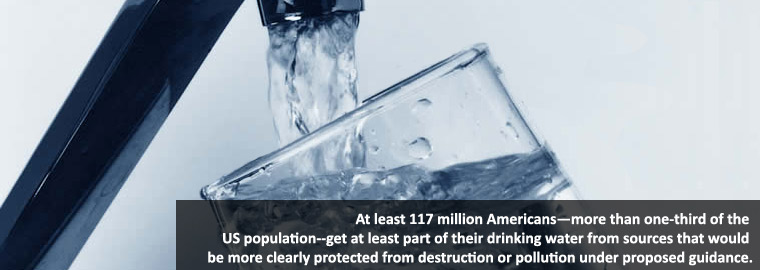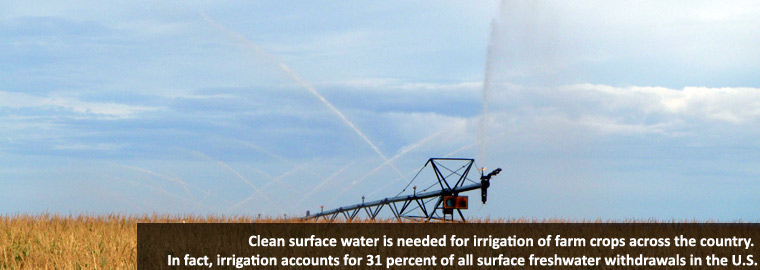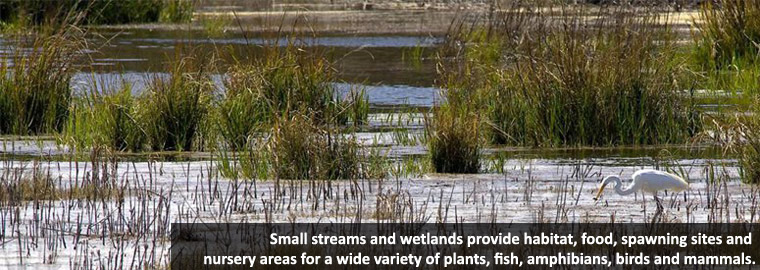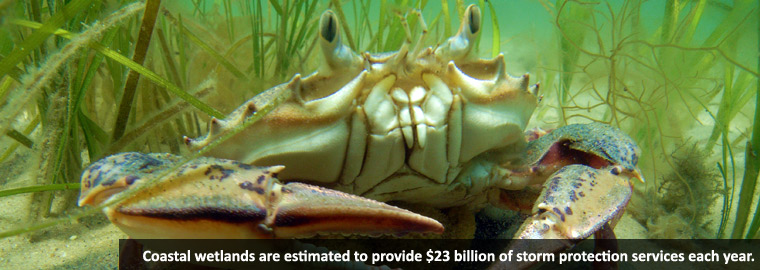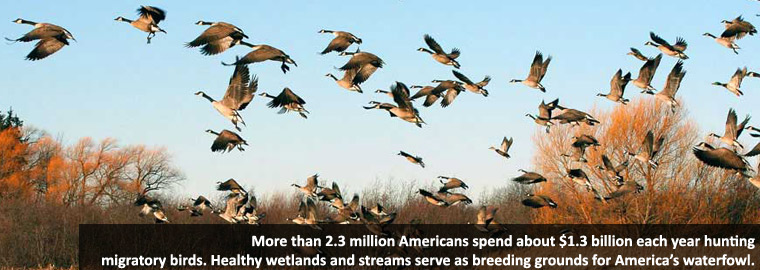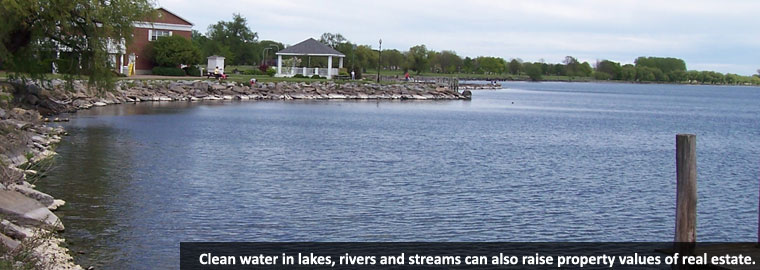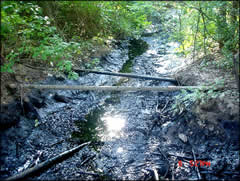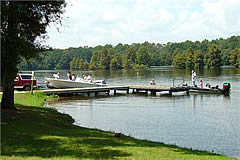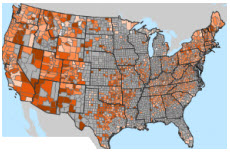Water: Wetlands
Clean Water Act Definition of "Waters of the United States"

You will need Adobe Reader to view some of the files on this page. See EPA's PDF page to learn more.
Clean water is the nation's most valuable natural resource and is relied on for drinking, recreation, manufacturing, energy development, agriculture, commercial fishing, tourism, and many other purposes that are essential to public health and the economy.
Since 1972, the Clean Water Act has protected our health and environment by reducing the pollution in streams, lakes, rivers, wetlands and other waterways. But over the past decade, interpretations of Supreme Court rulings have removed some waters from federal protection, and caused confusion about which waters and wetlands remain protected.
In April 2011, the EPA and the U.S. Army Corps of Engineers released draft guidance to clarify protection of waters under the Clean Water Act. About 230,000 public comments on the draft guidance were received by the agencies. Most recognized the importance of effective implementation of the Clean Water Act to protect human health and water quality.
EPA and the Army Corps of Engineers have submitted final guidance to clarify protection of waters under the Clean Water Act to the Office of Management and Budget for federal interagency review. The guidance will provide more predictable and consistent procedures for identifying waters and wetlands protected under the Clean Water Act.
The guidance is focused on protection of smaller waters that feed into larger ones, to keep downstream water safe from upstream pollutants. The focus is also on reaffirming protection for wetlands that filter pollution and store water and help keep communities safe from floods.
The guidance will not extend federal protection to any waters not historically protected under the Clean Water Act and will be fully consistent with the law, including decisions of the Supreme Court. The guidance will also maintain all of the existing exemptions for agricultural discharges and waters, and also identify specific types of water bodies to which it does not apply – areas like artificial lakes and ponds, and many types of drainage and irrigation ditches.
EPA and the Corps of Engineers have also heard requests from Congress, industry organizations, environmental groups, states and the public for rulemaking to further clarify the requirements of the Clean Water Act consistent with decisions of the Supreme Court. The agencies propose to finalize the guidance and to continue work on a rulemaking.
Tell EPA And Others What You Think About The Guidance
Learn More About The Guidance
- Update on Waters of the U.S. Draft Guidance
- Read the Proposed Guidance (PDF) (39 pp, 574K).
- Read the Federal Register Notice (PDF) (3 pp, 46K) about the proposed guidance.
Note: The public comment email address in the original Federal Register notice is incorrect. The correct email address to submit comments to the docket is ow-docket@epa.gov. - Read about traditional navigable waters (PDF) (3 pp, 57K).
- Read about how interstate waters (PDF) (17 pp, 149K) are waters of the US.
- Read about the proposed guidance's costs and benefits
- Read about "Why the draft guidance does not affect farmers" (PDF) (2 pp, 59K)
- Read the Guidance to Identify Waters Protected by the Clean Water Act Fact Sheet | PDF Version (2 pp, 28K)
Background Information
Select from the list below to expand the view and read further information on that topic.
Previous EPA Statements on Waters of the US
- Clean Water Act Jurisdiction Following the U.S. Supreme Court's Decision in Rapanos v. United States & Carabell v. United States (PDF) December 2, 2008 (13 pp, 1.1MB)
- Questions and Answers Regarding the Revised Rapanos & Carabell Guidance (PDF) (3 pp, 70K)
- Agencies Revise Guidance to Protect Wetlands and Streams - 12/03/08 News Release
- Response to Comments "Clean Water Act Jurisdiction Following the Supreme Court's Decision in Rapanos v. United States & Carabell v. United States Guidance" (PDF) (7 pp, 71K)
- The agencies accepted public comments on the Rapanos guidance until January 20, 2008. Use www.regulations.gov to access guidance comments (Docket number EPA-HQ-OW-2007-0282).
- June 2007 Legal Memorandum (PDF) (12 pp, 149K) discussing Clean Water Act Jurisdiction Following the U.S. Supreme Court Decision in Rapanos v. United States & Carabell v. United States.
- June 2007 Memorandum of Agreement (PDF) (7 pp, 131K) regarding Coordination on Jurisdictional Determinations under Clean Water Act Section 404 in Light of the SWANCC and Rapanos Supreme Court Decisions.
- For additional information, consult the Army Corps of Engineers Regulatory Program
- January 2003 Legal Memorandum (PDF) (4 pp, 54K) discussing the scope of the Clean Water Act jurisdiction in light of the SWANCC ruling and related court decisions.
Relevant Information about Water
- Drinking Water Analysis Relevant to Rapanos Decision is a GIS analysis aimed at illuminating dependence on intermittent, ephemeral, and headwater streams for water to supply public drinking water systems.
- Map of perennial stream length as a percentage of total stream length by watershed: Low Resolution (659K) or High Resolution (2.22MB)
- Journal of the American Water Resources Association's featured collection on the hydrological connectivity of headwater streams and their contributions to the integrity of downstream waters

- Environmental Law Institute's Clean Water Jurisidictional Handbook (Section Edition) provides an analysis of relevant case law, compilation of related scientific studies, and ELI's set of jurisdictional checklists.

- Field Operations Manual for Assessing the Hydrologic Permanence and Ecological Condition of Headwater Streams
- The Ecological and Hydrological Significance of Ephemeral and Intermittent Streams in the Arid and Semi-arid American Southwest (PDF) (116 pp, 2.6MB)
- NatureServe's Biodiversity Values of Geographically Isolated Wetlands

- Special Issue of the Journal Wetlands on isolated wetlands

- Association of State Wetland Managers Report entitled The SWANCC Decision and State Regulations of Wetlands

- Ducks Unlimited Report entitled The SWANCC Decision: Implications for Wetlands and Waterfowl

- U.S. Fish and Wildlife Service Report entitled Geographically Isolated Wetlands: A Preliminary Assessment of their Characteristics and Status in Selected Areas of the United States
Legal Background on Waters of the US
- Supreme Court decision in Rapanos v. U.S. and Carabell v. U.S. - June 19, 2006 (PDF) (104 pp, 787K)
- Post-Rapanos Caselaw on "Waters of the United States" (PDF) (3 pp, 27K)
- Supreme Court decision in Solid Waste Agency of Northern Cook County v. U.S. Army Corps - January 9, 2001 (PDF) (41 pp, 227K)
- Supreme Court decision in United States v. Riverside Bayview Homes, Inc. - December 4, 1985 (PDF) (10 pp, 161K)
Regulatory Definition of Waters of the U.S.
40 CFR 230.3(s) The term waters of the United States means:
- All waters which are currently used, or were used in the past, or may be susceptible to use in interstate or foreign commerce, including all waters which are subject to the ebb and flow of the tide;
- All interstate waters including interstate wetlands;
- All other waters such as intrastate lakes, rivers, streams (including intermittent streams), mudflats, sandflats, wetlands, sloughs, prairie potholes, wet meadows, playa lakes, or natural ponds, the use, degradation or destruction of which could affect interstate or foreign commerce including any such waters:
- All impoundments of waters otherwise defined as waters of the United States under this definition;
- Tributaries of waters identified in paragraphs (s)(1) through (4) of this section;
- The territorial sea;
- Wetlands adjacent to waters (other than waters that are themselves wetlands) identified in paragraphs (s)(1) through (6) of this section; waste treatment systems, including treatment ponds or lagoons designed to meet the requirements of CWA (other than cooling ponds as defined in 40 CFR 423.11(m) which also meet the criteria of this definition) are not waters of the United States.
(I) Which are or could be used by interstate or foreign travelers for recreational or other purposes; or
(ii)(From which fish or shellfish are or could be taken and sold in interstate or foreign commerce; or
(iii) Which are used or could be used for industrial purposes by industries in interstate commerce;
Waters of the United States do not include prior converted cropland. Notwithstanding the determination of an area’s status as prior converted cropland by any other federal agency, for the purposes of the Clean Water Act, the final authority regarding Clean Water Act jurisdiction remains with EPA.

